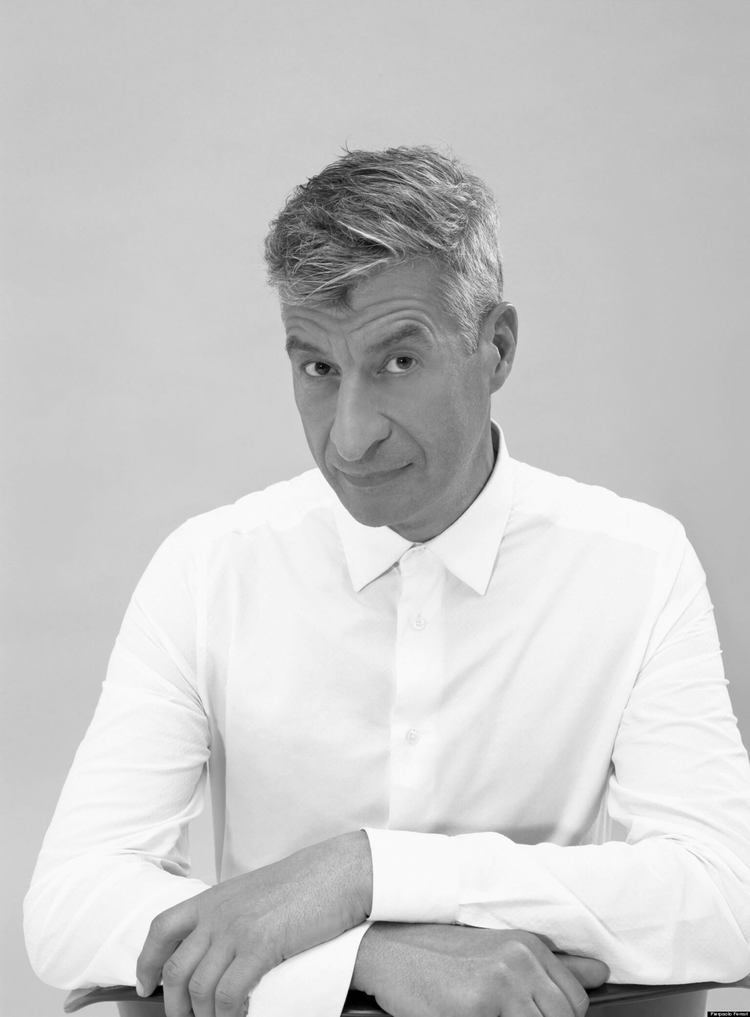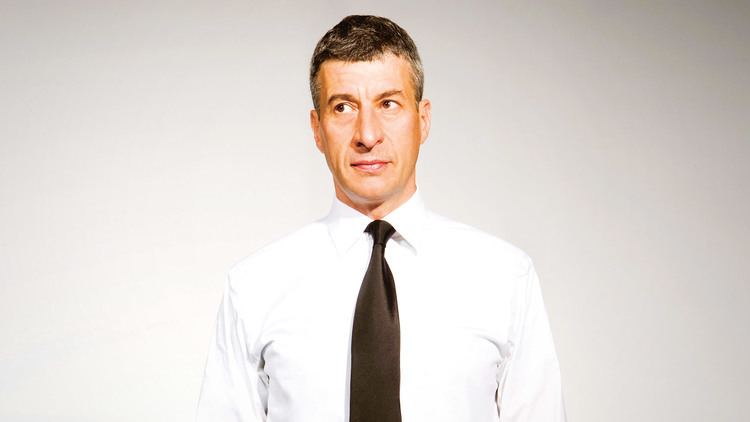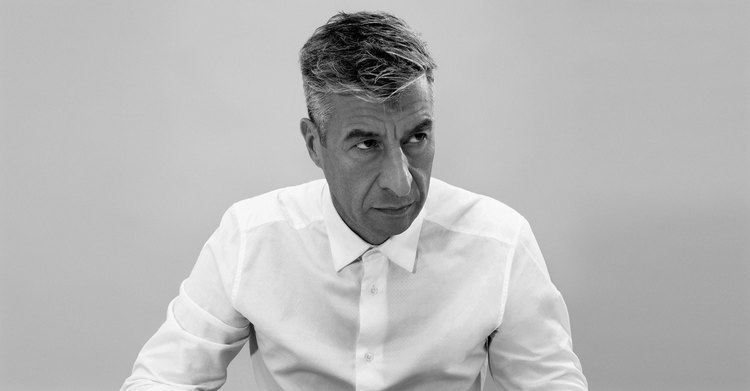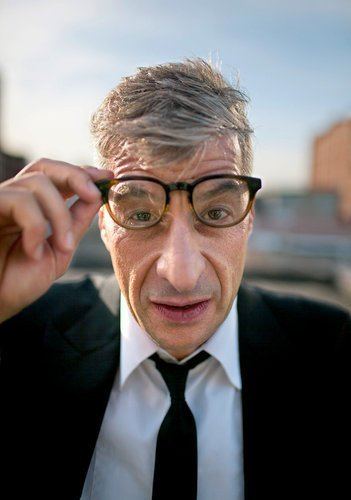Name Maurizio Cattelan Role Artist | Movies Platform Moon, Da Vinci | |
Books Maurizio Cattelan: All: Apple Edition, Visionaire No. 63: Forever, Lupetto: Pilot Issue Similar People Massimiliano Gioni, Yuri Ancarani, Linda Evangelista, Alessandro Cattelan | ||
Art safari maurizio cattelan
Maurizio Cattelan (born 21 September 1960, Padua, Italy) is an Italian artist. He is known for his satirical sculptures, particularly La Nona Ora (1999) (The Ninth Hour, depicting Pope John Paul II struck down by a meteorite), Him (2001), and Love Lasts Forever (1997).
Contents
- Art safari maurizio cattelan
- Media conference maurizio cattelan at fondation beyeler francesco bonami
- Early life and education
- Artistic style
- Selected works
- Magazine projects
- Exhibitions
- Recognition
- Art market
- Television
- References

Media conference maurizio cattelan at fondation beyeler francesco bonami
Early life and education

Cattelan started his career in the 1980s making wooden furniture in Forlì (Italy).

He created a sculpture of an ostrich with its head buried in the ground, wore a costume of a figurine with a giant head of Picasso, and affixed a Milanese gallerist to a wall with tape. During this period, he also created the Oblomov Foundation.
Artistic style

Cattelan’s personal art practice has gained him a reputation as an art scene’s joker. All his works have a humorous twist. He has been described by Jonathan P. Binstock, curator of contemporary art at the Corcoran Gallery of Art "as one of the great post-Duchampian artists and a smartass, too". Discussing the topic of originality with ethnographer, Sarah Thornton, Cattelan explained, "Originality doesn't exist by itself. It is an evolution of what is produced. [...] Originality is about your capacity to add."

Cattelan is commonly noted for his use of taxidermy during the mid-1990s. Novecento (1997) consists of the taxidermied body of a former racehorse named Tiramisu, which hangs by a harness in an elongated, drooping posture. Another work utilizing taxidermy is Bidibidobidiboo (1996), a miniature depiction of a squirrel slumped over its kitchen table, a revolver at its feet.

In 1999 he started making life-size wax effigies of various subjects, including himself. One of his best known sculptures, La Nona Ora (1999) consists of an effigy of Pope John Paul II in full ceremonial costume being crushed by a meteor.
Between 2005 and 2010 his work has largely centered on publishing and curating. Earlier projects in these fields have included the founding of "The Wrong Gallery", a store window in New York City, in 2002 and its subsequent display within the collection of the Tate Modern from 2005 to 2007; collaborations on the publications Permanent Food, 1996–2007- with Dominique Gonzalez Foerster and Paola Manfrin- and the slightly satirical arts journal "Charley", 2002–present (the former an occasional journal comprising a pastiche of pages torn from other magazines, the latter a series on contemporary artists); and the curating of the Caribbean Biennial in 1999. Along with long-term collaborators Ali Subotnick and Massimiliano Gioni, Cattelan also curated the 2006 Berlin Biennale. He frequently submitted articles to international publications such as Flash Art.
Cattelan’s art makes fun of various systems of order and he often utilizes themes and motifs from art of the past and other cultural sectors in order to get his point across. His work was often based on simple puns or subverts clichéd situations by, for example, substituting animals for people in sculptural tableaux. Frequently morbidly fascinating, Cattelan’s humour sets his work above the visual pleasure one-liners.
Cattelan utilizes media to expose reality as well as blur the lines between reality and myth. Several of Cattelan’s works play off of the modern day spectacle culture. If a Tree Falls in the Forest and There is No One Around It, Does It Make a Sound (1998) is a piece that exemplifies this idea. The work consists of a taxidermied donkey with its head bowed low, carrying a television on its back. It is meant to conjure up the image of Christ riding into Jerusalem on a donkey, for Palm Sunday. The television taking Christ’s seat on the Donkey serves a blatant representation of media culture's replacing tradition as the new object of praise. Hollywood (2001) is also re-figures a current reality in front of a new context. The whole of the work entails a giant replica of the southern California Hollywood sign overlooking a dump in Palermo, Sicily.
Cattelan’s manipulation of photos and his publications of magazine compilations such as Permanent Food and Charley did not come about without their influences. The artist attributes his love of finding the uncanny, the silly, or the seductive in just about any mundane or sensational object, as traceable to the works of Andy Warhol. As Cattelan states, “That’s probably the greatest thing about Warhol: the way he penetrated and summarized our world, to the point that distinguishing between him and our everyday life is basically impossible, and in any case useless.” Permanent Food and Charley differ in sophistication. Both consist of crude layouts, having magazine pages compiled together torn from outside sources. The latter, however, was backed by a wide list of recognizable and credible curators. His most recent publication, Toilet Paper, differs greatly from the two previously mentioned, as its photographs were originally planned and designated solely for the magazine. The level of originality for this magazine surpassed the others, providing the audience vague, oddly familiar photographs to peruse through. Toilet Paper is a surrealist pantomime of images that the viewer cannot easily trace back to a starting point, while they’ve most likely been conjured by popular culture. It is a whirlwind of loud colors mixed in with the occasional black-and-white photo: “the pictures probe the unconscious, tapping into sublimated perversions and spasms of violence.”
Selected works
Magazine projects
From 1996 to 2007, together with Dominique Gonzalez-Foerster and Paola Manfrin, Cattelan published 15 issues of Permanent Food: a magazine built by pages torn from other magazines.
In 2009, Cattelan teamed up with Italian photographer Pierpaolo Ferrari to create an editorial for W magazine's Art Issue. In 2010, they founded the magazine Toiletpaper, a bi-annual, picture-based publication. As part of a public art series at the High Line in 2012, Toiletpaper was commissioned with a billboard at the corner of 10th Avenue and West 18th Street in New York, showing an image of a woman’s manicured and jeweled fingers, detached from their hands, emerging from a vibrant blue velvet background. In 2014, Cattelan and Ferrari produced a fashion spread for the Spring Fashion issue of New York Magazine.
In the project entitled 1968, A Toiletpaper collaboration between Maurizio Cattelan, Pierpaolo Ferrari and the Deste Foundation in Athens, Cattelan celebrates the works and time of Dakis Joannou and his collection of radical design. "1968 is a collection of dreams and nightmares, an inspiring compendium of colorful, ironic materials, objects, and bodies. Toiletpaper's interpretation of the collection results in mind blowing photographs that trap us in a complex system of references, crossing layers, three dimensional and real time collages. 1968 is a rainbow, the memory of a storm and the positive projection of a newborn sun: the history plus the future, masterly shown in the drawings by one of the primary characters of the radical design movement, Alessandro Mendini, who adds a vital contribution to Toiletpaper's visuals."—P. [4] of cover.
On opening night of the Maurizio Cattelan retrospective at the Guggenheim Museum of New York, a Hummer stretch limo with the words “TOILETPAPER” printed on the side was not-so-discreetly parked outside the museum. The images in the magazine might appear to have been appropriated from world’s most surreal stock-photograph service, but they're all made from scratch. “Every issue starts with a theme, always something basic and general, like love or greed,” Cattelan has explained. “Then, as we start, we move like a painter on a canvas, layering and building up the issue. We always find ourselves in a place we didn’t expect to be. The best images are the result of improvisation". Many images are rejected, he said, because they're "not Toiletpaper enough". What makes a Toiletpaper photo? "We keep homing in on what a Toiletpaper image is. Like distilling a perfume. It's not about one particular style or time frame; what makes them Toiletpaper is a special twist. An uncanny ambiguity."
Exhibitions
Cattelan's work has been on view in numerous solo exhibitions, at the Migros Museum für Gegenwartskunst, Zurich; Artpace, San Antonio, Texas; Centre Georges Pompidou, Paris; the Kunsthalle Basel, Basel; Project 65 at the Museum of Modern Art, New York; as well as at Castello di Rivoli, Turin; Le Consortium, Dijon; the Hôtel des Monnaies, Paris; and Wiener Secession, Vienna. A major retrospective, assembling 130 objects of Cattelan's career since 1989, opened in 2011 at the Solomon R. Guggenheim Museum, New York. Cattelan has also exhibited at Skulptur Projekte Münster (1997), the Tate Gallery, London (1999), the Museum of Contemporary Art, Los Angeles (2003) and the Museum Ludwig, Cologne (2003), and participated in the Venice Biennale (1993, 1997, 1999, and 2002), Manifesta 2 (1998), Luxembourg, Melbourne International Biennial 1999, and the 2004 Whitney Biennial in New York. In 2004, Cattelan exhibited the controversial sculpture Untitled featuring 3 hanging kids for the Nicola Trussardi Foundation. In 2012, he participated in the group show Lifelike originating at the Walker Art Center.
On the occasion of his 2011-2012 retrospective exhibition at the Guggenheim Museum, Cattelan announced his early retirement. However, in 2016, he returned from retirement to create a new exhibit at the Guggenheim, Maurizio Cattelan: America. For America, Cattelan replaced a public toilet in the museum with a fully functional replica cast in 18-karat gold. The exhibit proved popular, with visitors lining up to wait for an opportunity to use the toilet in private.
Recognition
Cattelan was a finalist for the Guggenheim's Hugo Boss Prize in 2000, received an honorary degree in Sociology from the University of Trento, Italy, in 2004, and was also awarded the Arnold Bode prize from the Kunstverein Kassel, Germany, that same year. A career prize (a gold medal) was awarded to Maurizio Cattelan by the 15th Rome Quadriennale. On 24 March 2009, at the MAXXI Museum of Rome, the singer Elio of the Elio e le Storie Tese, who announced that he was the real Cattelan, came to receive the prize.
Art market
In 2004, one of Cattelan's best-known older pieces, a suspended, taxidermied horse titled The Ballad of Trotsky, was sold to Bernard Arnault in New York for $2.1 million (£1.15 million). Par Peur de l'Amour, a sculpture of an elephant hiding under a bedsheet that simultaneously conjures a child on Halloween and a Ku Klux Klan uniform, sold at Christie's in 2004 for $2.7 million. Maurizio Cattelan's Untitled (2001) was sold at an auction at Sotheby's 2010 for $7.9 million. The artist's proof of Him (2001) was sold at auction by Christie's in 2016 for $17,189,000.
Cattelan is represented by Emmanuel Perrotin in Paris, Massimo de Carlo in Milan, and Marian Goodman Gallery in New York.
Television
Cattelan appeared on American television program 60 Minutes. In 2016, a documentary about his life and work The Art World's Prankster: Maurizio Cattelan was broadcast on BBC.
